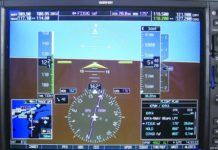AC 90-108 Conundrum
The FAAs Advisory Circular 90-108 just feels wrong. In it, section 8 itemizes circumstances where a suitable RNAV system (including GPS and GPS/WAAS equipment) cannot be used.
Briefing: January 2015
The loss of SpaceShipTwo during a test flight in November wont shut down Virgin Galactics space-tourism project, according to CEO Richard Branson. Branson also said he still plans to be aboard the first commercial passenger flight. NTSB staffers said their investigation wont be complete for about a year, but in the first few days after the accident, they found that the aircrafts feather mechanism -- a rotating tail boom intended to slow the aircraft on descent from high altitudes -- was prematurely deployed, and initiated the breakup of the aircraft at about 50,000 feet. Pilot Peter Siebold was injured but survived, and co-pilot Michael Alsbury was killed. A second spaceship is already under construction and is expected to launch in 2015.
TIS-B: The ADS-B Bridge
The great promise of ADS-B is that it will eventually offer free traffic and weather services for those pilots willing to pay for the equipment and displays. But until everyone has ADS-B Out-required by 2020-a technology called TIS-B (Traffic Information Services-Broadcast) will fill the trafffic gap, allowing you to see everything ATC sees within a reasonable range of a radar site, presuming you and the radar site are suitably equipped. Lets explore how TIS-B works and how it fits into the current state of ADS-B.
When Low Fuel Becomes No Fuel
One of the most famous and tragic of fuel-exhaustion crashes occurred on Jan. 25, 1990. Upon arrival in the New York area after a flight from Bogot, the 707 was placed into a hold for an hour and 27 minutes due to fog at JFK. The pilots were not native English speakers and never used the actual word emergency in describing their fuel situation to ATC, using only minimum fuel instead and never stating their fuel state in minutes. During that time, they burned away all the fuel they needed to make Boston, their alternate.
Briefing: February 2010
We now have approved technical and operational standards for ADS-B equipment-but dont get too excited. This really means (among other things) that manufacturers can now move forward to develop conforming ADS-B hardware. The FAAs final rule on what will be required for GA equipage to fly in controlled airspace isnt due until April of this year. Compliance isnt required for another decade-provided the system is up and running by then.
Readback: March 2010
I have a question that people have been asking me and I dont know the answer.The G1000 has two GPS receivers: GPS 1 is the default choice and automatically switches to GPS 2 if there is a problem. Or you can manually select GPS 2.My question is: Why can only one be used at a time? For example, one GPS could be the primary navigator with the flight plan and the other could indicate final destination or a waypoint on the side of the track or even an alternate.
Glass-Panel Scans
I had the pleasure of lunch several years ago with one of the designers of the Boeing 777 cockpit. She said something that has stuck with me for years: Good design obviates the need for training. Held up to this standard, our efforts for GA glass cockpits are a dismal failure. (Perhaps the 777 cockpit is as well; I dont know.)
Sorting Out NextGen
With high expectations, we set out to bring you a comprehensive report on those parts of NextGen-the next generation of air traffic control-that are now up and running. Intensive internet research plus interviews with many FAA controllers, FAA engineers, vendors, consultants and even FAA administrator Randy Babbitt, showed otherwise.
The Parenthetical Fix
Like many of our clinics, this one started with a readers letter. This particular fellow was a flight instructor who had to go old-school with a Private student in a Diamond DA20 equipped with a Garmin GNS 430 GPS. They were following V86-365 from the Bozeman VOR to the Livingston VOR at night through the mountains. Happily motoring along on GPS, they ran into a snag with the bend in the airway.
No Initial Fix Needed
Back when I used to teach science classes for elementary school students and their teachers, we used to say that a great question was one that generated an answer plus two more questions. Such it is with the RNAV (GPS) Rwy 33 approach to Easton, Md.
Riding a New LPV-200
The much-heralded promise of GPS/WAAS is ILS-like guidance at nearly every airport without the need for a million dollars worth of ILS equipment. The hero of this effort is the LPV approach-thats localizer performance with vertical guidance for those of you just coming up to speed.
Flying High and Visual
The forecast said that deep, moist convection was likely for your afternoon flight. On your drive to the airport, you second-guess the 10,000-foot altitude you filed. Should you have filed for the low to mid teens? Perhaps you should have filed a much lower altitude to try and stay below the clouds?












